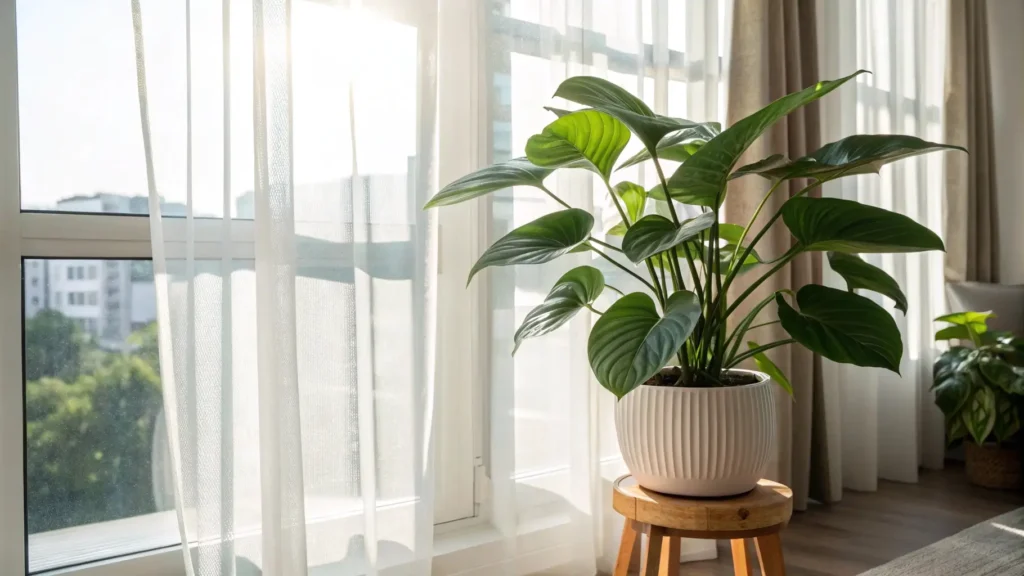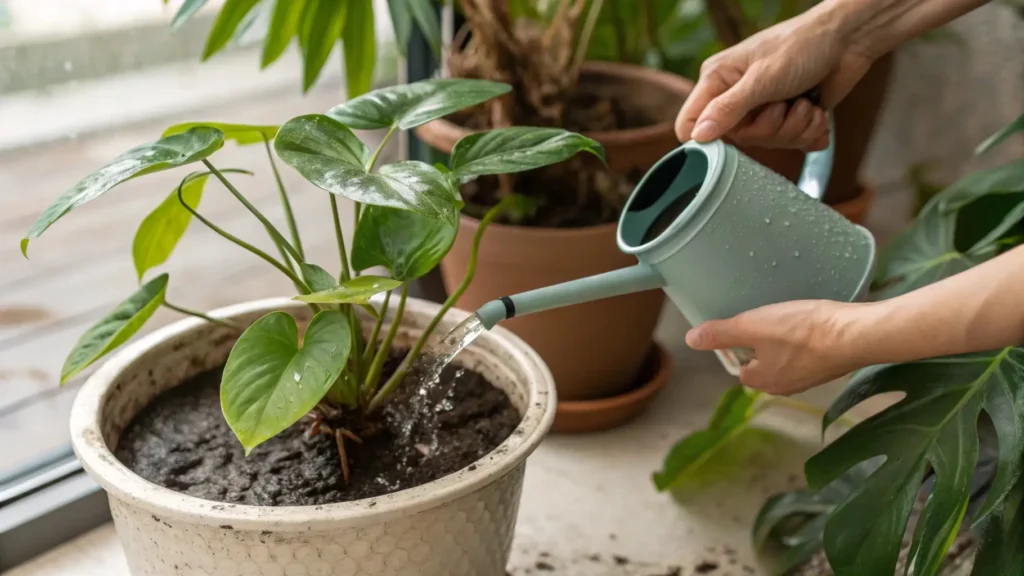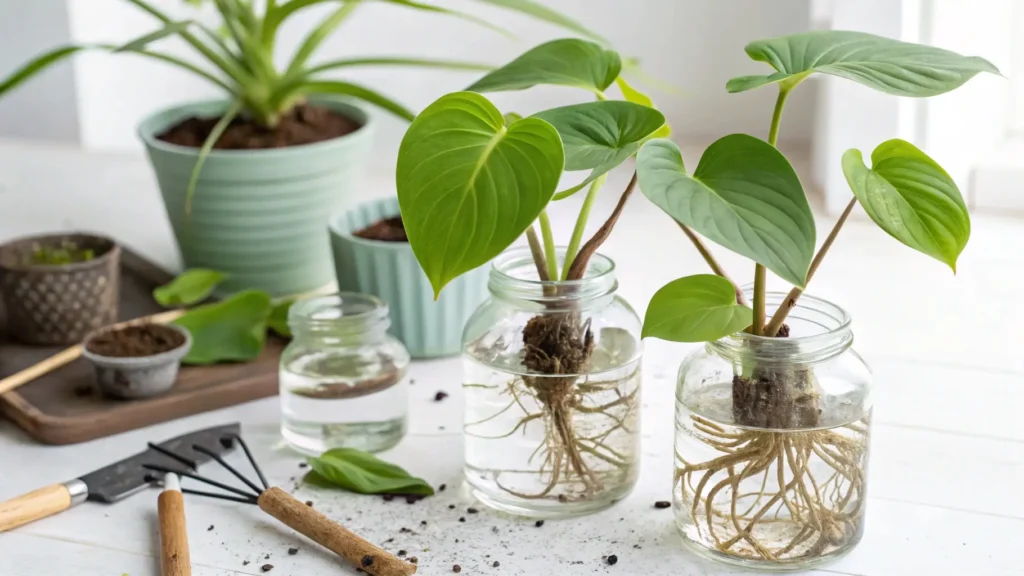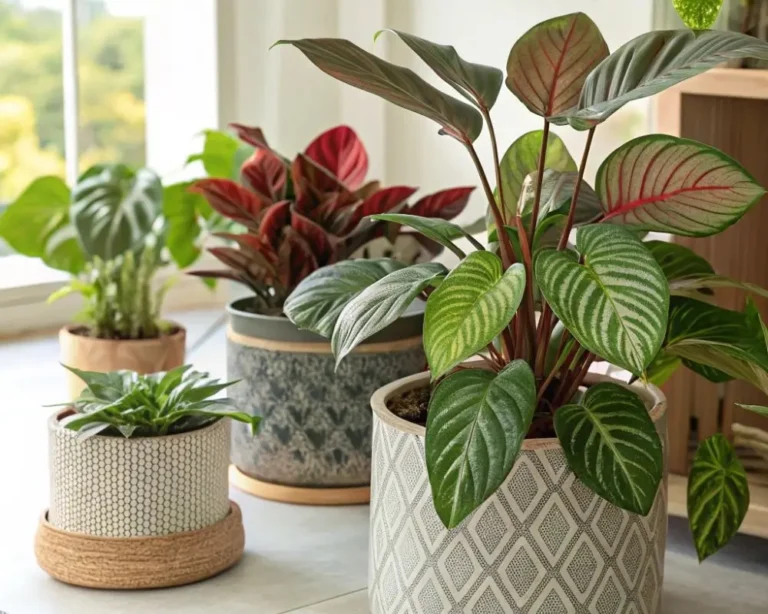If you’re looking to add a lush, tropical vibe to your home, Homalomena might just be the plant for you. These beauties are not only easy on the eyes with their heart-shaped leaves, but they’re also pretty low-maintenance. Perfect for those of us who love plants but can’t spend hours tending to them. Whether you’re a newbie or a seasoned plant parent, getting to know how to care for Homalomena can make all the difference in keeping them happy and healthy. So, let’s dive into some simple tips and tricks to help your adorable plant thrive.
Table of Contents
Understanding Homalomena Varieties
Popular Homalomena Species
When it comes to houseplants, Homalomena is a name that might not be as familiar as others, but it’s definitely worth knowing. This plant family has a bunch of species that are popular among plant enthusiasts. The rubescens variety for example, is often referred to as the “king of hearts” because of its glossy, heart-shaped leaves. Some favorites include the ‘Pink Splash’ with its bright green leaves splattered with white and pink, and ‘Mint’ which sports mint-colored foliage. Another notable species, wallisii, is known for its deep green leaves with light green-yellow patterns. The ‘Camouflage’ cultivar of this species has variegated leaves in mottled patterns.
Choosing the Right Homalomena for Your Home
Selecting the perfect Homalomena for your space can be a fun process. Consider the lighting conditions in your home first. These plants are pretty adaptable and can thrive in lower light, making them suitable for rooms without much natural sunlight. If you want a plant that stands out, the ‘Purple Sword’ with its silver-spotted green leaves and burgundy underside could be a great choice. For something a bit more subtle, the ‘Emerald Gem’ with its dark green, waxy leaves might be ideal. Think about the space you have, too, since some varieties can grow quite large.
Unique Features of Homalomena Varieties
Homalomena plants are not just about looks; they have some unique traits that make them appealing. Their leaves, which can range from deep green to vibrant variegated patterns, are typically heart-shaped or oval. This shape is why they’re sometimes called “queen of hearts” or “shield plant.” The foliage is often waxy and lush, making them a striking addition to any room. Although their flowers are not the main attraction, their foliage definitely steals the show. Plus, these plants are known for being low-maintenance and resilient, perfect for both beginners and seasoned plant lovers.
Beyond their heart-shaped leaves, this plant varieties boast unique features that rival the intriguing look of the Rhipsalis cactus, known for its trailing stems and minimal care needs.
Optimal Light Conditions :

Bright Indirect Light Benefits
Homalomena plants thrive in bright, indirect light. This means they should be placed where they can soak up plenty of light without being directly in the path of the sun’s rays. Direct sunlight can scorch their leaves, causing them to lose their vibrant colors. Their glossy leaves are best maintained with the right balance of light.
Adapting to Low Light Environments
One of the great things about Homalomena is their adaptability to different light conditions. While they prefer indirect light, they can still manage in lower light settings. However, expect slower growth and less vibrant leaves in these conditions. If you notice the leaves becoming pale or dull, it might be time to move them to a brighter spot.
Homalomena plants excel at adapting to low light environments, much like the versatile Hosta plant, which thrives in shaded areas and adds lush greenery to dim corners.
Signs of Light Stress
Keeping an eye on your plant’s leaves can tell you a lot about their light preference. Here are some signs of light stress:
- Yellowing leaves: This often means too much direct sunlight.
- Faded or scorched leaves: Indicates overexposure to light.
- Slow growth or leggy stems: A sign that your plant isn’t getting enough light.
Homalomena’s light green-yellow patterns can be a beautiful feature, but they need the right light conditions to really shine. Avoid placing them in areas with harsh, direct sunlight to prevent damage.
Watering Techniques

How to Water Homalomena Correctly
Watering your Homalomena the right way is key to keeping it healthy. This tropical plant enjoys a consistent water routine, but not too much. Let the top inch of soil dry out before you water again. This ensures the roots stay moist without sitting in excess water, which can lead to root rot. Pour water at the base of the plant, avoiding the hued leaves to prevent fungal issues. Remember, the freshest plant drinks slowly, so let the water soak in gradually.
Avoiding Overwatering and Root Rot
Overwatering is a common mistake with Homalomena care. Signs of too much water include yellowing leaves and soft stems. To avoid this, ensure your pot has proper drainage. Here’s a quick checklist:
- Use a pot with drainage holes.
- Check the soil moisture before watering.
- Remove any excess water from the saucer.
These steps help prevent leaf damage and keep your plant’s thick, green spade-shaped leaves vibrant.
Seasonal Watering Adjustments
As seasons change, so should your watering routine. During spring and summer, when the plant is actively growing, it needs more water. In winter, when growth slows, reduce watering. Cold weather can make the plant turn yellow if overwatered, so adjust accordingly. Keep an eye on leaf edges; if they start to brown, it might be a sign of leaf burn from inconsistent watering.
Homalomena, with its heart-shaped or spade-shaped leaves, is a fun and low-maintenance houseplant. By understanding its watering needs, you ensure it stays a lush, green centerpiece in your home.
Soil and Potting Essentials for Homalomena
Choosing the Right Potting Mix
Homalomena, a compact plant native to South America, thrives in well-drained potting mixes. These plants dislike soggy soil, so it’s crucial to select a mix that allows water to escape easily. A blend designed for tropical plants or aroids often works well, ensuring the soil stays moist but not waterlogged. Avoid using acidic soils, as they can harm plant health. Instead, aim for a neutral to slightly acidic pH.
Repotting
Repotting is generally needed every 1-2 years, or when you see signs of the plant becoming root-bound, like roots poking through the drainage holes. Choose a container plant pot that’s just one size larger than the current one to prevent excessive soil moisture. Use fresh potting soil during repotting to provide the plant with new nutrients and improve its overall health.
For detailed guidance, check out this comprehensive guide on repotting plants from the University of Georgia, which explains step-by-step how to choose the right pot and prepare the soil.
Ensuring Proper Drainage
Proper drainage is vital to prevent root rot in your Homalomena. Select a pot with ample drainage holes to allow excess water to escape. You can place a pebble tray under the pot to catch drained water and increase humidity around the plant. Regularly check that the soil drys out slightly between waterings to avoid overwatering, which can lead to root rot.
Homalomena, often likened to the hosta plant for its lush foliage, is a beloved houseplant for its resilience and beauty. Keeping its soil conditions optimal ensures it remains a vibrant part of your indoor garden.
Maintaining Ideal Temperature and Humidity
Temperature Preferences for Homalomena
Homalomena plants thrive in warm environments, ideally between 70°F and 85°F during the day and not dropping below 60°F at night. Cold temperatures can be quite harmful, causing the leaves to yellow and eventually die. If your space tends to be cooler, consider relocating your plant to a warmer spot, away from any drafts or chilly windows.
Increasing Humidity Levels
These tropical beauties love humid conditions, so aim for humidity levels above 50%. If your home is on the dry side, especially in winter, there are a few tricks to boost humidity. You can place a humidifier nearby, or try setting the plant on a tray filled with pebbles and water. Just make sure the pot isn’t sitting directly in the water. Misting the leaves can also help, but avoid overdoing it, as too much moisture can lead to fungal issues.
Protecting Homalomena from Drafts
Poor air circulation and drafts can stress your Homalomena. Keep it away from windows or doors that open frequently, especially during colder months. If you notice the leaves curling or browning, it might be a sign that your plant is experiencing stress from temperature changes or low humidity. Consistent growth is best achieved by maintaining a stable environment for your plant.
Keeping your Homalomena in the right temperature and humidity range ensures it remains healthy and vibrant. A little attention to its environment goes a long way in preventing stress and promoting lush growth.
Feeding and Fertilizing
Best Fertilizers
Feeding your Homalomena is crucial for its growth and vibrant foliage. During the growing season, which typically kicks off in spring and stretches through summer, you’ll want to feed your plant every 4-6 weeks. Opt for a balanced, water-soluble fertilizer that’s specially formulated for houseplants. This ensures your plant gets all the necessary nutrients without overwhelming it.
Fertilizing Schedule and Tips
- Spring and Summer: This is the prime growth period starts for your Homalomena. Fertilize every 4-6 weeks using a diluted fertilizer solution.
- Fall and Winter: As the plant’s growth slows, reduce or stop fertilizing. Over-fertilizing during these months can harm your plant.
- Application Tips: Always water your plant before applying fertilizer to avoid root burn. Apply the fertilizer directly to the soil, not on the leaves.
Avoiding Over-Fertilization
Over-fertilization is a common mistake that can stunt your plant’s growth or even damage it. Signs of over-fertilization include yellowing leaves and a white crust on the soil surface. If you notice these, flush the soil with water to remove excess fertilizer salts. Remember, less is often more when it comes to feeding your Homalomena.
Consistent care and attention to your Homalomena’s feeding schedule will reward you with a lush, thriving plant. Adjust your approach as needed based on the plant’s response and seasonal changes.
Common Pests and How to Manage Them
Identifying Common Homalomena Pests
Like many houseplants, these plants can fall victim to a variety of pests. The usual suspects include spider mites, mealybugs, and scale insects. Spider mites are especially tricky because they’re tiny and can go unnoticed until they’ve done some damage. Keep an eye out for webbing and tiny moving dots on the undersides of leaves
Natural Pest Control Methods
- Regular Inspections: Check your plants weekly for any signs of pests. Early detection is key.
- Neem Oil Spray: This natural pesticide can be effective against a range of pests. Apply it every two weeks as a preventive measure.
- Insecticidal Soap: For a quick fix, insecticidal soap can help manage an infestation. Make sure to cover all plant surfaces.
Preventing Pest Infestations
- Maintain Humidity: Many pests, like spider mites, thrive in dry conditions. Keeping humidity levels up can deter them.
- Isolate New Plants: Before introducing a new plant to your collection, keep it isolated for a week or two to ensure it’s pest-free.
- Clean Leaves Regularly: Dusty leaves can be a breeding ground for pests. Wipe them down with a damp cloth every so often.
Remember, a healthy plant is less likely to be attacked by pests. Regular care and attention go a long way in keeping your Homalomena thriving.
Fungal diseases can also be a concern, especially if the plant is overwatered or the air circulation is poor. It’s essential to strike a balance with watering and ensure your plant has good airflow. Additionally, troubleshooting common issues like yellowing leaves can help maintain overall plant health and prevent potential pest problems.
Propagation Techniques for Homalomena

Propagating Homalomena from Cuttings
If you’re looking to expand your Homalomena collection, propagation through cuttings is a straightforward method. Start by selecting a healthy stem with a few leaves. Using a sharp, clean knife or scissors, cut a piece of the stem. Ensure you leave a few leaves on top. Plant this cutting in a pot filled with fresh, well-draining soil. Place the pot in a spot with bright, indirect light and keep the soil moist. Within a week or so, you should notice new growth, signaling successful propagation.
Dividing Rhizomes for New Plants
Dividing rhizomes is another effective way to propagate Homalomena, especially during the active growth period. Once your plant is well-established, usually after a year or two, you can divide it instead of repotting. Carefully remove the plant from its pot and gently separate the rhizomatous roots into sections. Replant each section in its own pot with fresh soil, maintaining the same depth as the original plant. This method not only helps in creating new plants but also controls the growth rate of your existing specimen.
Caring for Newly Propagated Homalomena
Once you’ve propagated your plant, it’s crucial to care for the new specimens properly to ensure they thrive. Here’s a quick guide:
- Watering: After planting, water the new sections thoroughly but avoid waterlogging.
- Light: Position them in a location with bright, indirect light to encourage healthy growth.
- Fertilization: Hold off on fertilizing until the plants are well-established. This helps them focus on root development.
Propagating Homalomena can be a rewarding experience, allowing you to enjoy more of these beautiful plants throughout your home. With patience and the right care, your new plants will flourish, adding lush greenery to your space.
Wrapping It Up: Your Homalomena Journey
So, there you have it, folks! Taking care of this plant isn’t rocket science, but it does need a bit of attention. Keep an eye on the light, water just right, and don’t forget about the humidity. These beauties are pretty forgiving, so even if you mess up a little, they’ll likely bounce back. Just remember, every plant is different, so what works for one might not work for another. Give it some love, and it’ll brighten up your space with its lush, green leaves. Happy planting!
Frequently Asked Questions
What is the best light condition for Homalomena?
Homalomena thrives in bright, indirect light but can also adapt to low-light areas. Avoid direct sunlight as it can harm the leaves.
How often should I water my Homalomena?
Water your Homalomena when the top inch of soil feels dry. Ensure the pot has good drainage to prevent root rot.
What type of soil is suitable for Homalomena plants?
Use a well-draining potting mix, preferably one designed for tropical plants or aroids, to keep your Houseplant healthy.
How can I increase humidity for my Homalomena?
You can increase humidity by misting the leaves, using a humidity tray, or placing a humidifier nearby.
What temperature range is ideal for Homalomena?
Homalomena prefers temperatures between 65°F to 80°F. Keep it away from cold drafts to prevent damage.
Are Homalomena plants safe for pets?
No, Homalomena plants are toxic if ingested by pets or humans, so keep them out of reach of children and animals.

